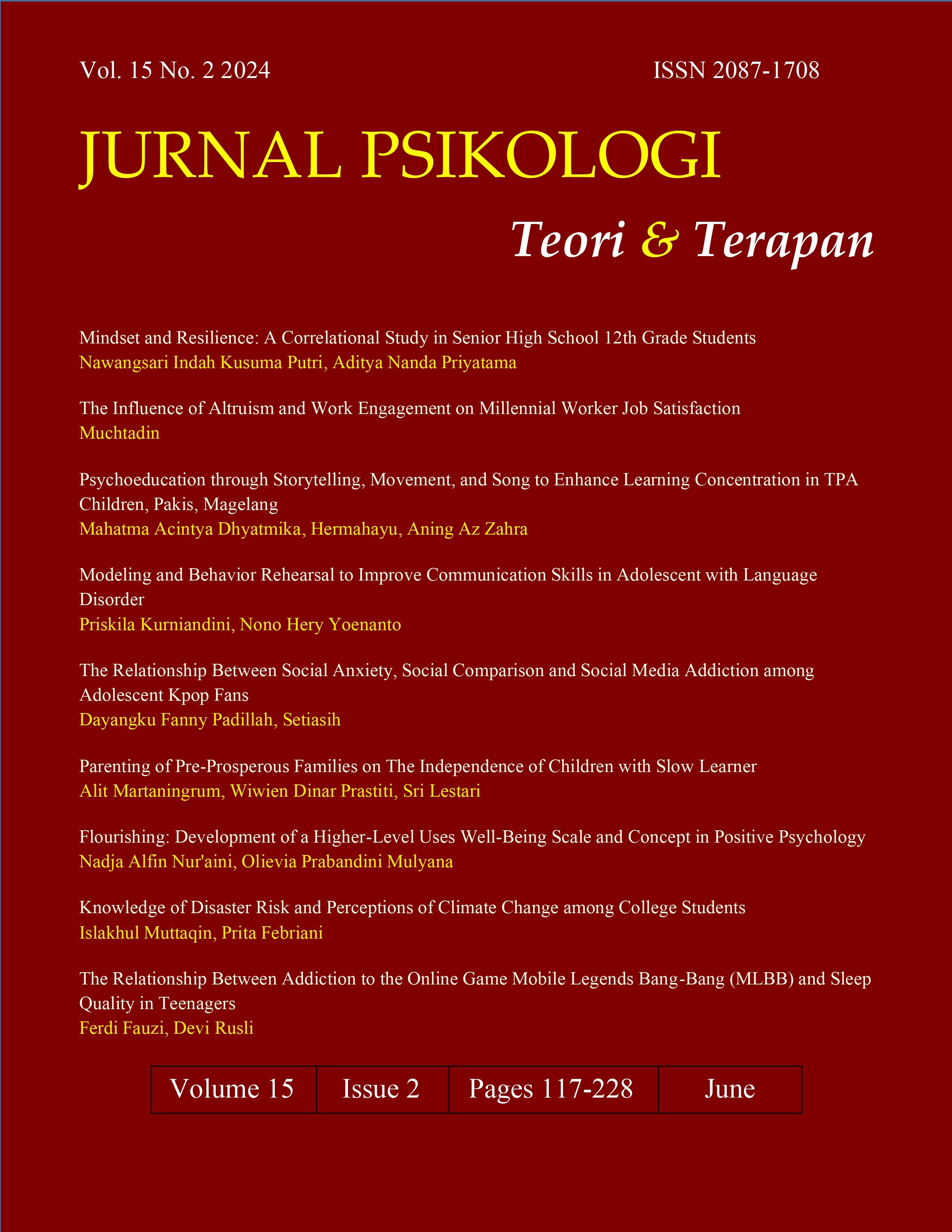Knowledge of Disaster Risk and Perceptions of Climate Change among College Students
DOI:
https://doi.org/10.26740/jptt.v15n02.p208-217Keywords:
Climate change, disaster risk, college student, perubahan iklim, risiko bencana, mahasiswaAbstract
Indonesia is on the path of the Pacific Ring of Fire so all regions in Indonesia are prone to disasters. The last ten years have also seen many disasters in several areas. The reason is climate change which has an impact on erratic weather. This study aims to determine the effect of knowledge of disaster risk on perceptions of climate change in college students. Quantitative research method with 101 student subjects. The measurement tools used are disaster risk knowledge and climate change perceptions. The results of the study show that there is a relationship between knowledge of disaster risk and perceptions of climate change among college students. The effective contribution shows 39.3%, meaning that disaster risk knowledge contributes 39.3% to climate change perceptions, and 69.7% is influenced by other factors. The results also show that students' knowledge of disaster risk is low and students' perceptions of climate change are negative. The results of this study are important as a basis for making interventions in the form of more effective and massive education for students about disaster risk.
References
Azizah, M., Apriadi, R. K., Januarti, R. T., Winugroho, T., Yulianto, S., Kurniawan, W., &Widana, I. (2022). Disaster Risk Assessment Based on the Number of Disaster Events and Impacts in Indonesia for the 2010-2020 Period. PENDIPA Journal of Science Education, 6(1), 35-40.
National Disaster Management Agency (BNPB). (2012). Guidelines for organizing disaster management preparedness exercises. BNPB. Jakarta.
Birkholz, S., Muro, M., Jeffrey, P., & Smith, H. M. (2014). Rethinking the relationship between flood risk perception and flood management. Science of the Total Environment, 478, 12-20. https://doi. org/10.1016/j.scitotenv.2014.01.061
Bubeck, P., Botzen, W. J. W., & Aerts, J. C. J. H. (2012). A Review of Risk Perceptions and Other Factors that Influence Flood Mitigation Behavior. Risk Analysis, 32(9).
Chapagain, BK, Subedi, R & Paudel, NS (2009). Exploring local knowledge of climate change: Some reflections. Journal of Forest and Livelihood, vol. 8, no. 1, pp. 108-12.
Clayton, S., Devine-Wright, P., Stern, P. C., Whitmarsh, L., Carrico, A., Steg, L., et al. (2015). Psychological research and global climate change. Nature Climate Change, 5 (7), 640-646. https://doi.org/10.1038/nclimate2622
Daryono. (2009). Assessment of Local Site Effect in Graben Bantul Using Seismic Vulnerability Index Based on Microtremor Measurement. Indonesian Disaster Journal Vol. 2, No.1 May 2009. Yogyakarta: PSBA
Efendi, M., Sunoko, H. R., & Sulistya, W. (2012). Das-Based Climate Change (Case Study of Garang Sub Watershed). In Proceedings of the National Seminar on Natural Resources and Environmental Management (pp. 27-32).
Gifford, R., Kormos, C., & McIntyre, A. (2011). Behavioral dimensions of climate change: drivers, responses, barriers, and interventions. Climate Change, 2(6), 801-827. doi: 10.1002/wcc.143.
Haryanto, H. C., & Prahara, S. A. P. (2017). Do you believe in climate change? INQUIRY: Scientific Journal of Psychology, 8(2), 88-99.
Hasriyanti, N., Zuletstari, A., Ruslan, I., & Agustrihardaning, L. (2019). Analysis of Disaster Vulnerability Capacity in Mempawah Hilir Subdistricts. International Journal of Built Environment and Scientific Research, 3(2), 71-80.
Ho, M. C., Shaw, D., Lin, S., & Chiu, Y. C. (2008). How do disaster characteristics influence risk perception? Risk Analysis, 28(3), 635-643. https://doi.org/10.1111/ j.1539-6924.2008.01040.x.
Hornsey, M. J., Harris, E. A., & Fielding, K. S. (2018). Relationships among conspiratorial beliefs, conservatism and climate scepticism across nations. Nature Climate Change, 8(7), 614-620. https://doi.org/10.1038/s41558-018-0157-2
Kung, Y. W., & Chen, S. H. (2012). Perception of Earthquake Risk in Taiwan: Effects of Gender and Past Earthquake Experience. Risk Analysis, 32(9), 1535-1546. https:// doi.org/10.1111/j.1539- 6924.2011.01760.x.
Mertz, O, Mbow, C, Reenberg, A & Diouf, A (2009), Farmers perceptions of climate change and agricultural adaptation strategies in Rural Sahel. Environmental Management, vol. 43, no. 5, pp. 804- 16.
Journal of Theoretical and Applied Psychology, Vol. xx, No.xx, Month Year
Notoatmodjo, Soekidjo. (2012). Health education and behavior. Jakarta: Rineka Cipta
Nurdin, N., Rafliana, I., Hidayati, S., Oktari, R. S., & Djalante, R. (2017). Integrating Disaster Risk Reduction and Climate Change Adaptation into School Curricula: From National Policy to Local Implementation. In R. Djalante, M. Garschagen, F. Thomalla, & R. Shaw (Eds.), Disaster Risk Reduction in Indonesia: Progress, Challenges, and Issues (pp. 213-234). Springer International Publishing
P. Stephen. Robbins and Timothy A. Juge. (2008). Organizational Culture. translator Diana Angelica. Jakarta: Fourth Edition.
Pan, A., (2012), A Study on Resident's Risk Perception in Abrupt Geological Hazard. Journal of Risk Analysis and Crisis Response, Vol.2, No.1, 44-55, Wenzhou, China
Prabhakar, S. V. R. K., Srinivasan, A., & Shaw, R. (2009). Climate change and local level disaster risk reduction planning: Needs, opportunities and challenges. Mitigation and Adaptation Strategies for Global Change, 14(1), 7-33. https://doi. org/10.1007/s11027-008-9147-4.
Purwanto, Heri. (1998). Introduction to Human Behavior. Jakarta: EGC
Ruin, I., Gaillard, J-C., and Lutoff, C. (2007). How to Get There? Assessing Motorists' Fash Food Risk Perception on Daily Itineraries. Environ Hazards, 7(3): 235-244.
Schmidt, M. R. (2004). Investigating Risk Perception: A Short Introduction. Loss of Agro-Biodiversity in Vavilov Centers, with a Special Focus on the Risks of Genetically Modified Organisms GMOs, October, 1-16. http://www.markusschmidt.eu/pdf/ Intro_risk_perception_Schmidt.pdf.
Setiawan, H. (2014). Analysis of coping strategies and the level of local community's capacity towards landslide-a case study in Tawangmangu, Karanganyar, Central Java. Forestry Social and Economic Research, 11(1), 70-81.
Shahzad, U., & Riphah. (2012). Global Warming -Causes, Effects and Solution'sTrials. Journal of Engineering Sciences, 40(4), 1233-1254.
Swim, J., Clayton, S., & Doherty, T. (2011). Psychology and global climate change: Addressing a multi- faceted phenomenon and set of challenges. https://www.apa.org/science/about/publications/climate- change.pdf.
Terpstra, T. (2011). Emotions, Trust, and Perceived Risk: Affective and Cognitive Routes to Flood Preparedness Behavior. Risk Analysis, 31(10), 1658-1675. https:// doi.org/10.1111/j.1539- 6924.2011.01616.x
Tingsanchali, T. (2012). Urban Flood Disaster Management. Procedia Engineering, 32, 25 -37.
United Nations International Strategy for Disaster Reduction (UNISDR). (2009). UNISDR Terminology on Disaster Risk Reduction 2009; United Nations International Strategy for Disaster Reduction: Geneva. Switzerland.
Uprety, Y., Poudel, R.C., Shrestha, K.K. et al. Diversity of use and local knowledge of wild edible plant resources in Nepal. J Ethnobiology Ethnomedicine 8, 16 (2012). https://doi.org/10.1186/1746-4269-8- 16
van Valkengoed, Anne & Steg, Linda & Perlaviciute, Goda. (2021). Development and validation of a climate change perceptions scale. Journal of Environmental Psychology. 76. 101652. 10.1016/j.jenvp.2021.101652
Wachinger, G., Renn, O., Begg, C., & Kuhlicke, C. (2013). The risk perception paradoximplications for governance and communication of natural hazards. Risk Analysis, 33(6), 1049-1065. https://doi. org/10.1111/j.1539-6924.2012.01942.x.
Weber, E. U. (2010). What shapes perceptions of climate change: What shapes perceptions of climate change? Wiley Interdisciplinary Reviews: Climate Change, 1(3), 332-342. https://doi.org/10.1002/wcc.41.
Downloads
Published
How to Cite
Issue
Section
License

This work is licensed under a Creative Commons Attribution-NonCommercial 4.0 International License.
Authors who publish in this journal agree to the following terms:
Copyright in any article is held by the author.
The author grants the journal, publication rights with the work simultaneously licensed under a Creative Commons Attribution License that allows others to share the work with an acknowledgment of the work's authorship and initial publication in this journal.
Authors may enter into separate, additional contractual arrangements for the non-exclusive distribution of the journal's published version of the work (e.g., posting it to an institutional repository or publishing it in a book), with an acknowledgment of its initial publication in this journal.
Authors are permitted and encouraged to post their work online (e.g., in an institutional repository or on their website) prior to and during the submission process, as this can lead to productive exchanges, as well as earlier and greater citation of published work.
 Abstract views: 469
,
Abstract views: 469
, PDF Downloads: 307
PDF Downloads: 307


















